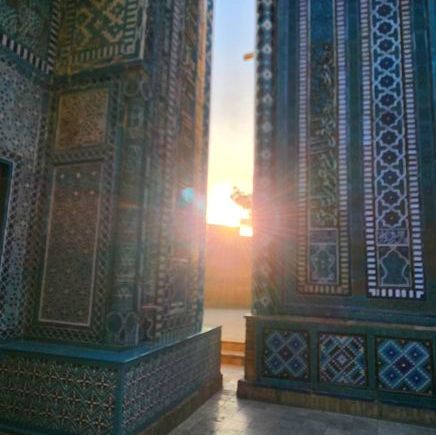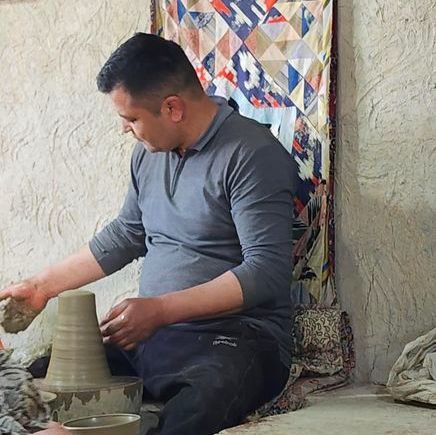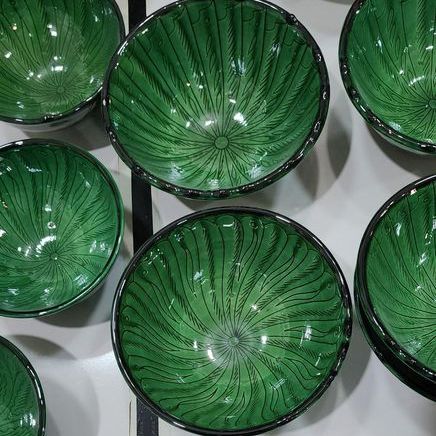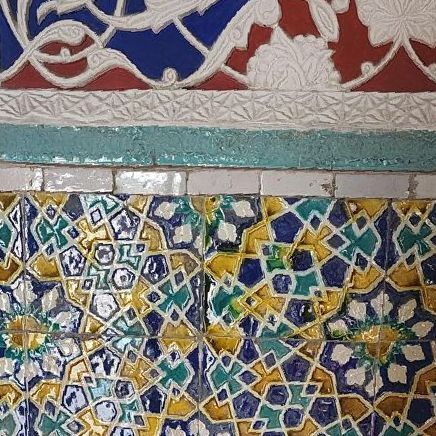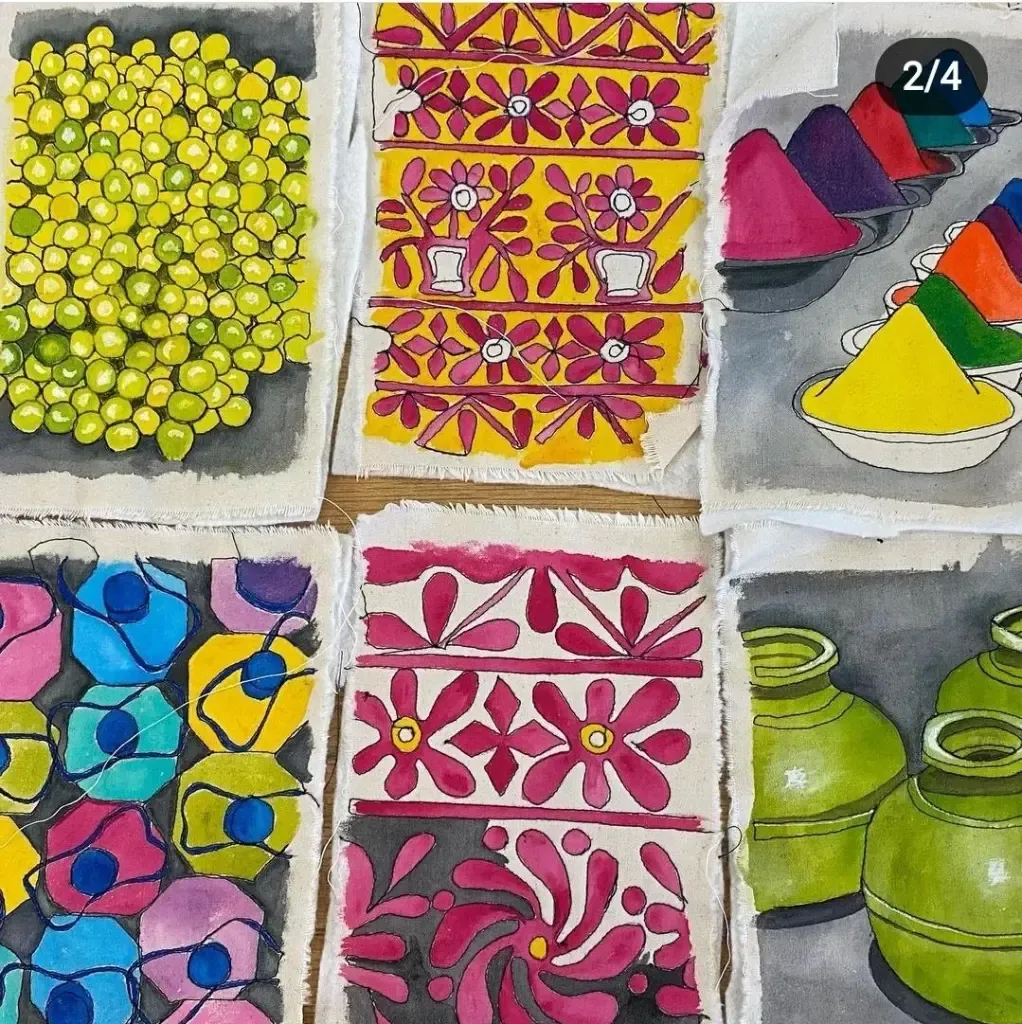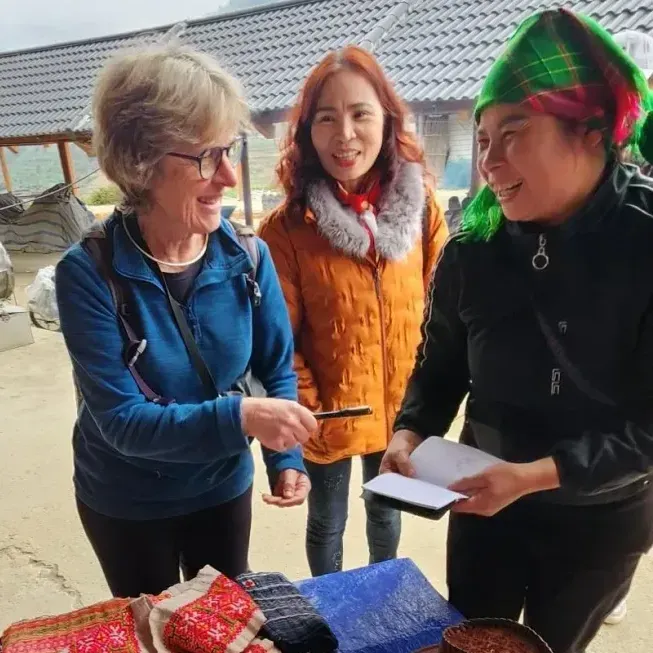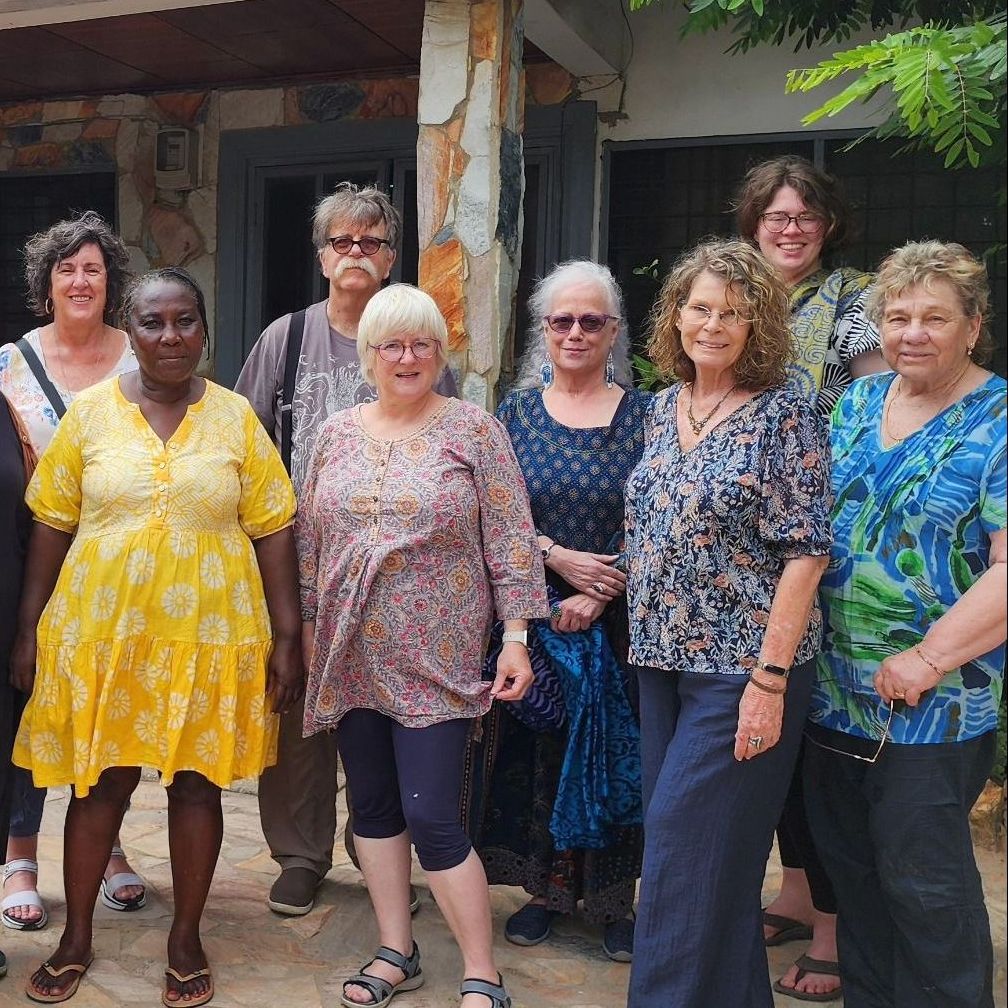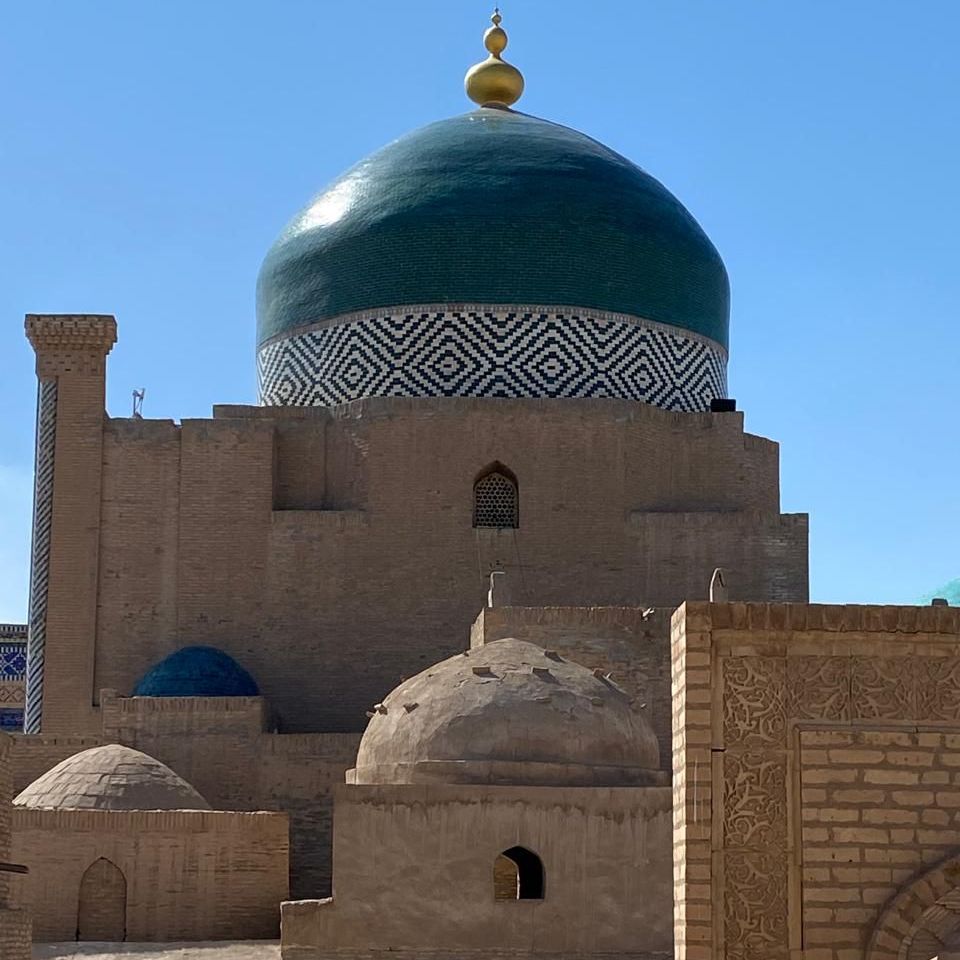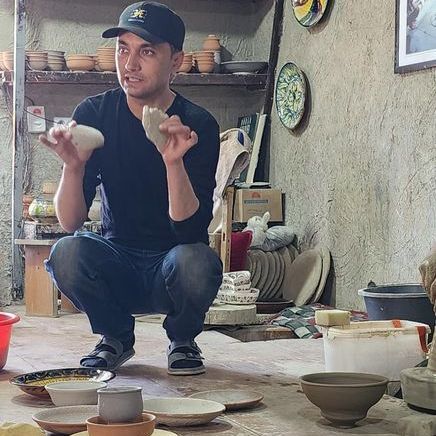
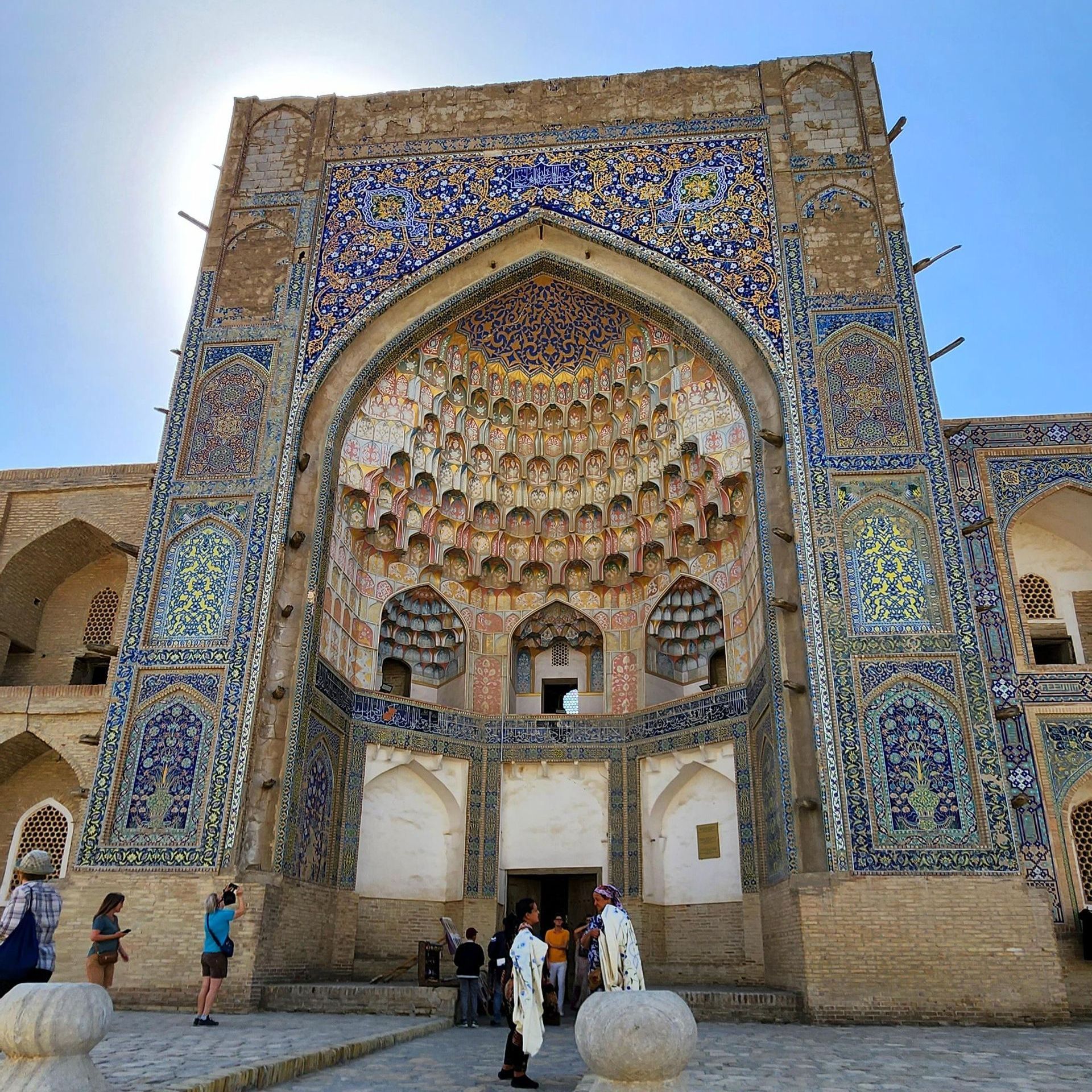
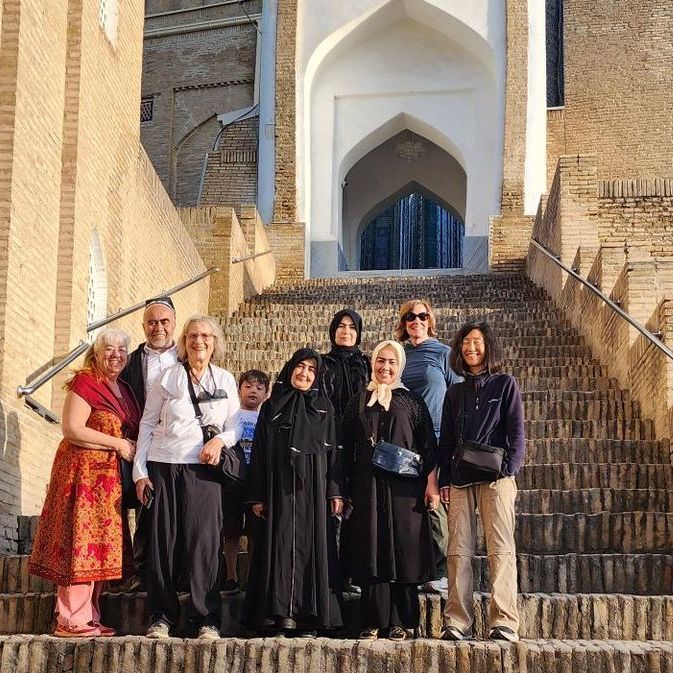
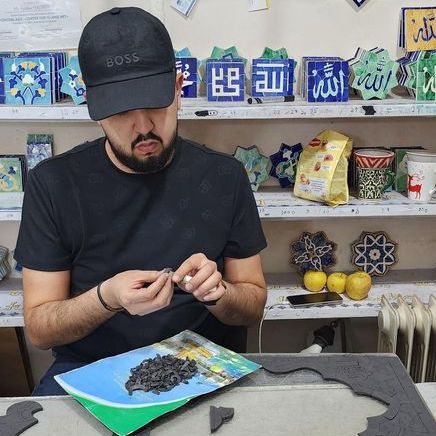
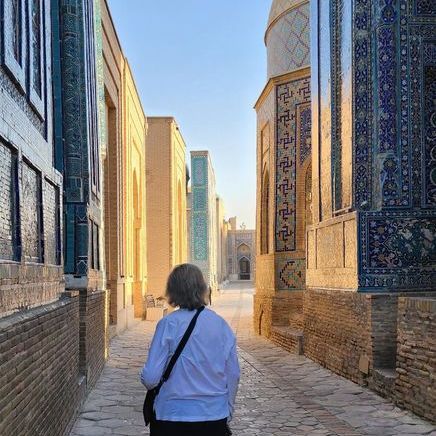
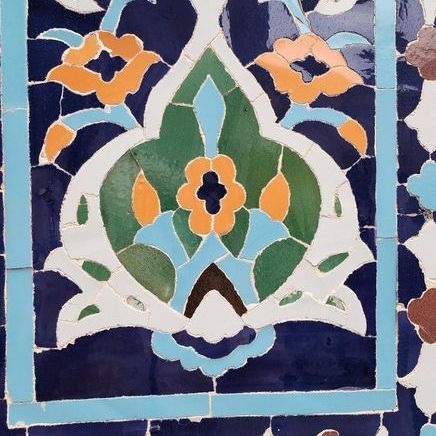
Uzbekistan Ceramics Tour - All Fired Up
Pottery has been part of human civilisation for millennia, constantly evolving alongside us. But it was the arrival of glazes in the late 8th century that truly shaped the rich tradition of Uzbek ceramics we see today.
Join us in the heart of this heritage - get your hands dirty, explore local styles, learn about firing techniques and glazes, and create your own pieces to bring home with you.
4-16 April 2026
FULL - join us in 2 - 15 April 2027
From
Duration
13 days / 12 nights
All Fired Up!
Get ready to work alongside artisans on your own pieces.
Uzbekistan has a long and rich history of ceramics.
- The earliest pottery centre sprang up not far from Samarkand in the ancient settlement of Afrasiab.
- Gijduvan ceramic pottery, which began in Bukhara in the 3rd century AD, is renowned for its distinctive floral patterns in shades of green, brown, and blue.
- Another important ceramic centre is Rishtan, famous for its signature blue glaze known as
Ishkor. This natural dye, derived from plant ash, has been used since the 8th century. The striking blue and turquoise hues produced with Ishkor have become a much-desired feature in Uzbek ceramics and architecture alike.
We plan to meet the makers - often families who can trace their craft through generations, preserving and evolving the techniques and traditions of Uzbek ceramics.
Alongside these personal encounters and time taking hands-on workshops, we’ll explore the rich history and culture of the region.
Can't miss visiting some of Uzbekistan’s most inspiring monuments, many of them encrusted with stunning tiles in the iconic blue and turquoise hues that define the country's artistic heritage.
Optional add-on
Aral Sea Extension.
Since the 1970s, the Aral Sea has been drying up—an ecological tragedy that gave rise to the haunting ship graveyard of Moynaq. Life has become incredibly difficult for the people living in the region, but change is in the air.
Come and experience this remarkable landscape: travel by 4WD across the old seabed, stay in traditional yurts, explore ancient ruins, and discover inspiring new initiatives focused on rejuvenating the area.
Day 1 - Tashkent, Uzbekistan (4 April 2026 )
Arrival at Islam Karimov Tashkent International Airport, Uzbekistan.
We’ll pick you up from the airport at any time, day or night.
There is no scheduled program today, as guests will be arriving throughout the day. Your room will be available from 2:00 PM. We’ll all come together and be ready to begin our exciting adventures tomorrow morning.
Day 2 - Tashkent (5 April)
Let's dive into the ceramics scene in Tashkent visiting the studio of an innovative young ceramicist Sunjar. Originally from Samarkand he has moved his studio to Tashkent. Tea pots and planters for bonsai are his specialties. You will come to see that teapots and tea are a very important part of Uzbek Culture.
Next a visit to the Museum of Applied Arts - start and get a feel for Uzbek motifs and the richness of their Crafts Culture.
This afternoon we are guests at Rakhimov's Studio. This family will proudly introduce us to their 8th generation in the studio. They are very much artists and historians as well as potters - it will be a wide ranging look at history, styles of ceramics and the nitty gritty of their working methods and glazes.
Welcome Dinner tonight to celebrate our travels.
B,L,D
Day 3 - Kokund (6 April)
An early morning train to the Fergana Valley today.
We get off in Kokund in time for lunch at a local tea house.
Then we will meet Rustam and his family, their studio will be our workshop space for the next few days.
Today is an introductory session. We don't have time to make a piece from start to finish so we will be talked through their process, then choose a premade blank to decorate and glaze ourselves, once fired you'll have a pice to take home with you.
Today you will choose you base piece to work on tomorrow - perhaps you'll like to draw a design up tonight to use or work free hand when we come back in the morning.
B,L,D
Day 4 - Kokund (7 April)
We are off to the workshop today to add designs to our pieces.
If there is time we will poke around Risthan, there are many ceramics workshops.
B,L
Day 5 - Tashkent (8 April)
Time to explore Kokund and its history
Kokand was the centre of a fabulously wealthy Khanate. It originated in the 10th century and reached its pinnacle in in the 18th Century.
When the Russian's colonized the region the Khanate was the last bastion of resistance and much of their architectural heritage was wiped out.
We will visit the Palace of Khudayar Khan to explore, it is quite different in style to places we will see later. Much of the palace was destroyed by invading Russians only 19 of the original 120 rooms still stand.
The Kokand Congregational Mosque is architecturally fascinating and houses a Cultural Centre and artisans workshops, well worth a visit.
Metal work, fine cloth, woodwork are all significant crafts of the area, along with ceramics.
Local markets are always interesting to explore, fresh produce and people watching make a good match.
We will gather up some fresh bread, salads and local cheese for our train trip this afternoon.
If our pottery is ready we will collect it before catching the afternoon train back to Tashkent, otherwise it will be delivered to us in Tashkent at the end of our trip.
B,L
Day 6 - Bukhara (9 April)
Early morning flight to Bukhara, we will be collected by our mini-bus and head out to Gijduvan.
People have inhabited the region around Bukhara for at least five millennia, and the city has existed for half that time.
Located on the Silk Road, the city has long served as a center of trade, scholarship, culture, and religion. Bukhara served as the capital of the Khanate of Bukhara, Emirate of Bukhara and later Bukhara People’s Soviet Republic.
We are visiting a family workshop, these traditions have been handed from father to son through many generations. During the time of the USSR when private business was not allowed Abdulla and his father secretly made and fired small runs of plates to keep the recipes and skills alive in their hands. Today they welcome visitors from all over the world and generously share their craft.
Abdulla uses traditional methods and local raw materials in manufacturing ceramics. In his workshop, he and his family make more than 50 traditional forms on a pottery wheel and all glazes are prepared in house. Pieces are fired in a traditional kiln using wood, petroleum, or natural gas.
We will be shown all their processes, meet the donkey who grinds their glazes. He lives a privileged life, fed well and only one day of work each month!
Plates will be ready for you to paint with their beautiful earthy glazes. We will leave the pieces to be fired and collect them in a few days on our way to Samarkand.
We stay in the heart of the Old City of Bukhara.
B,L
Day 7 - Bukhara (10 April)
Today is special - we will visit Kushtak potter Roza.
Roza was quite surprised when we tracked her down and said we had a group of foreigner guests who would like to know about her work.
Kushtak aren't common and when you do see them they are often sold as a child's toy but there history is ancient and much more important than that.
They are shaped like fantasy or real animals. Sculpted from clay and fired, they are partially or completely decorated with polychrome painting. Some were additionally covered with glaze. Traditionally, khushtak are an element of the rituals of the Spring Equinox day, originating in folk beliefs and magic. Popular with Uzbeks and Tajiks, they are associated with the celebration of the Eastern New Year - Navruz.
According to ancient tradition, their sound was supposed to scare away an evil dragon, symbolizing winter. Some also believed that their whistle could cause the wind and then the rain needed to cultivate the land.
Roza is happy to invite us to her home, she will have blank forms ready for you to paint and take with you. May they chase the winter dragons from your home.
Home cooked lunch and a free afternoon.
If anyone is keen happy to take a walk across to the Ismail Samani Mausoleum.
It was used between 892 and 943 CE and is known for its detailed brickwork and served as the mausoleum for rulers of the Samanid dynasty. The structure is a significant example of early Islamic architecture and is one of the few surviving monuments from the Samanid era and is known as the oldest funerary building of Central Asian architecture.
It is just near the Bukhara Central Market so let's go over there and check out what is available- it is a great place for a little Street food research too.
B,L
Day 8 - Bukhara (11 April)
We will start with a Guided walk of Bukhara Ark and monuments.
The Ark of Bukhara is a massive fortress located in the city of Bukhara, Uzbekistan, that was initially built and occupied around the 5th century AD. In addition to being a military structure, the Ark encompassed what was essentially a town that, during much of the fortress's history, was inhabited by the various royal courts that held sway over the region surrounding Bukhara. The Ark was used as a fortress until it fell to Russia in 1920.We are visiting a family of painters. Minatare Paintings have a long and rich history in the Islamic World and the rich kingdom of Bukhara was famous for its ateliers.
Lunch is a well loved local place, great range of meals and somsa available. This is where the Ladies of Bukhara lunch - yum.
During the USSR times it was an art expressly forbidden but new life has been breathed into this artform and we are visiting masters of it.
We'll learn about the manufacture of mulberry paper and take a workshop ourselves.
B,L,D
Day 9 - Samarkand (12 April)
We will visit the Fayzulla Khodjaev Museum - this is a wealthy merchants family home built around 1880.
Fayzulla Khodjaev, himself grew up in privilege and he was sent to Moscow by his father in 1907. There he realized the tremendous gap between contemporary European society and technology, and the ancient, tradition-bound ways of his homeland, after his father's death in 1912 Fayzulla used is wealth to try to bring change to Bukhara.... after a long and twisted path he ended up in 1924, as the first Chair of the Revolutionary Committee of the Uzbek SSR – at which time he was recognized as the head of government.
However, Xoʻjayev opposed Joseph Stalin's heavy-handed control, particularly in the matter of cotton monoculture. Although he retained his post as head of government, from 1929 his influence and access to Moscow waned. In March 1938, Fayzulla was arraigned at the Trial of the Twenty-One in Moscow, found guilty and executed.
Drop by the pottery in Gijduvan for another great lunch and to pick up our fired plates and then off to Samarkand.
The area around the Registan is always lively, it is a beautiful monument and the people watching is excellent.
When we arrive we will drop our bags and head up to check it out on our way to dinner.
We can point out where we are and places you might like to walk to in any free time - our hotel has a fantastic location close to everything.
B,L,D
Day 10 - Samarkand (13 April)
We'll have a guide to visit the Registan this morning, we also check out mosaic makers in Uglegbeg Madrassa,
Later we will walk down to the Bibi-Khanyan Mosque -a vast, partially restored ruins of an ornate 1400s mosque with a landmark, blue-tiled dome.
Lunch in a local teahouse along the way.
Lots of gossip surround the building of this mosque, I'm sure our guide will spill.
B,L
Day 11 - Samarkand (14 April)
The Afrasiyab Museum of Samarkand is a museum located at the historical site of Afrasiyab, one of the largest archaeological sites in the world and the ancient city that was destroyed by the Mongols in the early 13th century. It bears the name of Afrasiab, mythical king and hero of Turan, an ancient Persian Kingdom.
Opened in 2007 The opening of the museum was dedicated to the 2500th anniversary of the founding of the city of Samarkand.
The town of Afrosiyob was occupied from 500 BC to 1220 AD when it was wiped out by Genghis Khan. Excavations uncovered the now famous Afrasiab frescoes in the last century.
Timur chose the area to found his city of Samarkand near the ruins of Afrasiyab in the 14th Century.
Samarkand is famous for its plov.
Day 12 - Tashkent (15 April)
We will visit golden Timur Mausoleum when it opens this morning, then drive to Tashkent.
Let's share a final dinner together and celebrate our epic journey.
B,L,D
Day 13 - Departures (16 April 2026)
Departures from Islam Karimov Tashkent International Airport, Uzbekistan.
We’ll drop you to the airport to meet your flight.
B
Packing your Ceramics
The safest way to get your ceramics home will be for you to pack them safely and carry them yourself. Sending via courier is a risky undertaking.
Please bring bubble wrap and a sturdy carry bag suitable to carry your pieces home.
Fitness
Physical Fitness for Sightseeing
This adventure is crafted for enthusiastic, active travellers with a good general level of health and mobility.
To make the most of your experience, you’ll need to be comfortable walking for 3–4 hours a day — sometimes over uneven ground, up hills, and climbing a few flights of stairs.
You may also find yourself getting in and out of local transport and navigating the occasional over-the-bath shower.
If you enjoy a bit of daily movement and love discovering new places on foot, you’ll thrive on this tour.
Just a friendly heads-up: we need to walk at an average pace - it will not be suitable for those who prefer a slow pace or need frequent rest stops.
Booking Status
Bookings OPEN
Tour Location
Uzbekistan
Tour Information
Tour Pricing
- Share with a Friend: AUD $TBA each when booking two places at the same time, twin or double room share.
- Happy to share if someone is looking for a roommate.
- Private Room - Add AUD $TBA
- Deposit: AUD $TBA due today secures your place.
- Early Bird Bonus: Book by 4 Sept 2026 to receive a $200 rebate.
- Triple Treat Bonus? Every 3rd trip earn AUD $300 discount and our appreciation.
Destination Notes- to help you prepare.
Inspirational Reading List.
Inclusions
Expert instruction by local artisans and workshop fees
Solo Traveller friendly
Fully hosted by our CAS teams with local guides
Carefully curated itinerary & well located accommodations
Internal flight
Airport pick up & drop off
All breakfast and most other meals
Exclusions
International Flights
Visa, if needed
Travel insurance
Laundry
Gratuities

